Australia 2013 "Australia's Age of Dinosaurs"
| <prev | back to index | next> |
| Issue Date | 24.09.2013 |
| ID | Gummed | self-adhesive Michel: 4017A-4022A, Bl. 174 | 4023-4026 Scott: 3986-3991, 3991c | 3992-3995 Stanley Gibbons: 4061-4066, MS4067 | 4069-4071 Yvert et Tellier: 3865-3870, BF173 | 3871-3873 Category: pR |
| Designer | Illustration: James Gurney Product design: Sonia Young |
| Stamps in set | 6 |
| Value |
60c - Koolasuchus 60c - Serendipaceratops 60c - Timimus 60c - Diamantinasaurus 60c - Qantassaurus 60c - Australovenator |
| Emission/Type | commemorative |
| Issue place | Inverloch, Vic 3996 |
| Size (width x height) | 30mm/50mm x 50mm/30mm ; 25mm/30mm x 30mm/25mm ; 26mm x 37.5mm. Mini-Sheet size: 172mm x 80mm |
| Layout |
Sheets of 50 for mint stamps, Mini-Sheet of 6 stamps, Booklets of 10 and 20 self-adhesive stamps |
| Products |
FDC x 2 (gummed stamps and Mini-Sheet), Mini-Sheet x1, Maxi-Cards x6, Medallion Covers x2, Novelty "pop-up" pack x1, Prestige-Booklet x1, Presentation-Pack x1 (include 8 M/S), Booklet of self-adhesive stamps x2 (10 and 20 stamps), Gutter-pairs x4 (10 stamps each), Impressive Collection - set of special Mini-Sheets x1 (8 M/S). |
| Paper | gummed: Tullis Russell, self-adhesive: B100 |
| Perforation |
gummed: 14.6 x 13.86 self-adhesive: die cut 11 |
| Print Technique | Lithography |
| Printed by | McKellar Renown |
| Quantity | |
| Issuing Authority | Australia Post |

At the end of September 2013, twenty years after the issue of "Australia's Dinosaur Era.", the Australian Post issued a second set of stamps, "Australia's Age of Dinosaurs".
Similar to stamps of 1993 this issue contain six mint stamps issued in Mini-Sheet and individual sheets of 50 stamps, four of the six stamps were issues as self-adhesive in booklets of 10 and 20.
These stamp issues illustrate six prehistoric animals that lived in Australia during the Cretaceous period (around 145 million years ago to 65 million years ago).
- Koolasuchus cleelandi - amphibian, not a dinosaur (discovered in Victoria)
- Serendipaceratops arthurcclarkei (discovered in Victoria)
- Timimus hermani (discovered in Victoria)
- Diamantinasaurus matildae (discovered in Queensland), in the sky above Diamantinasaurus are pterosaurs, or flying reptiles
- Qantassaurus intrepidus (discovered in Victoria)
- Australovenator wintonensis (discovered in Queensland)
- Kryoryctes Echidna like mammal (known from a single bone from the Otway Group of Dinosaur Cove) is shown on the bottom left side of the Mini-Sheet, in front of Serendipaceratops
That interval just happens to be the time of greatest change in the evolution of land plants since they first emerged from the sea just over 400 million years ago. Flowering plants arose and came to dominate the land between 120 and 95 million years ago.
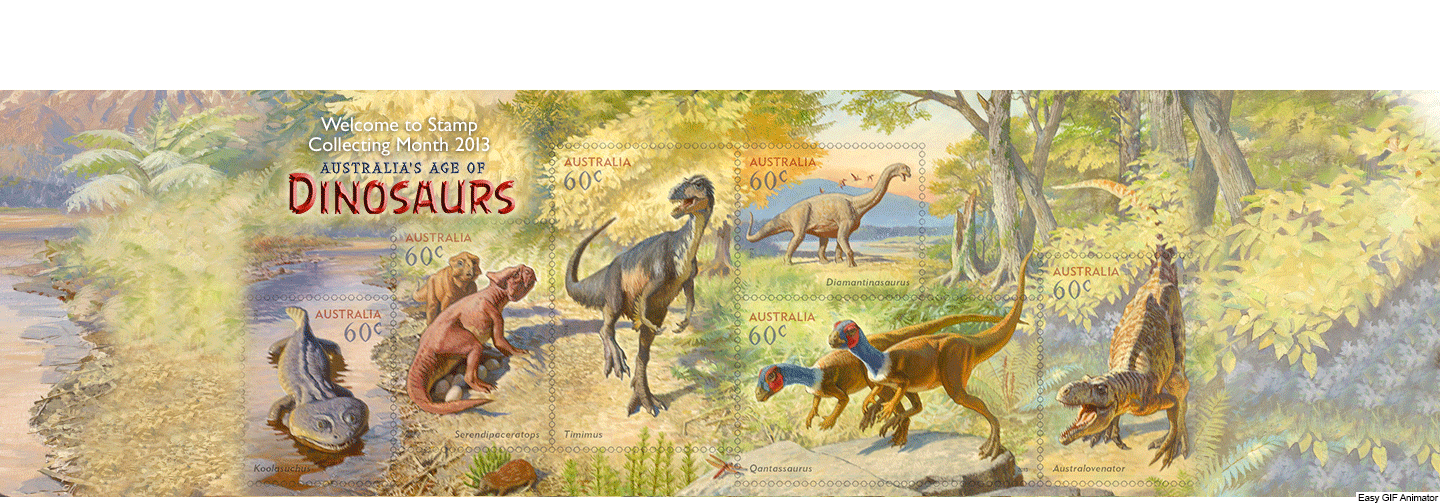 Banner credit: Australian Post
Banner credit: Australian Post
The particular animals chosen were from Queensland and Victoria because it is in those two states that the vast majority of dinosaur material has been found on this continent. The amphibian and with one exception, all the dinosaurs depicting, have never previously been illustrated on stamps.
The one exception is Timimus, a dinosaur that is now interpreted as a member of a quite different group than when illustrated on an Australian stamp in 1993.
Timimus is a genus of small coelurosaurian theropod dinosaur from the Early Cretaceous of Australia. It was originally identified as an ornithomimosaur, but now it is thought to be a different kind of theropod, possibly a tyrannosauroid.
 |
 |
|
| Timimus dinosaur on stamps of Australia 1993, MiNr.: 1373, Scott: 1345 and Australia 2013, MiNr.: 4019, Scott: 3988. | ||
Around the same time, Chinese palaeontologists started reporting amazing discoveries of feathered carnivorous dinosaurs in Liaoning Province, north-eastern China. Subsequently, another dinosaur specimen, a partial pelvis, turned up in tunnel excavated at Dinosaur Cove, Victoria, close to where the first Timimus fossils were collected.
The Dinosaur Cove in Victoria, Australia is a fossil-bearing site in the south-east of
the continent where the Otway Ranges meet the sea to the west of Cape Otway, adjacent to Great Otway National Park.
The inaccessible ocean-front cliffs include fossil-bearing strata of the Eumeralla Formation that date back to about
106 million years ago and has provided discoveries important in the research of the natural history of dinosaurs in
Australia and the Southern Hemisphere as a whole.
In 1903, geologist William Hamilton Ferguson was mapping the rocky coastal outcrops a few kilometres west of
Inverloch (the stamps issue place)
and uncovered the first dinosaur fossil ever discovered in Australia.
75 years later, the exploration and excavation of the Dinosaur Cove site was conducted by teams of volunteers
overseen by Dr. Tom Rich, Senior Curator of Vertebrate Palaeontology at Museums Victoria and his wife Patricia Rich,
an Australian Professor of Palaeontology and Palaeobiology.
No other relatives of Tyrannosaurus rex, or ornithomimosaurs for that matter, had thigh bones as thin relative to their length. This suggests that this human-sized dinosaur was a fast runner, regardless of which group it belonged to.
Any reconstruction of the dinosaur is hypothetical, based on an interpretation of the available fossil remains. This was as true in 1993 as it is now. Science may be thought of as a collection of hypotheses always subject to further testing. Hypotheses that stand up to repeated tests became robust theories. The two reconstructions of Timimus that have appeared on two different Australian postage stamps two decades apart are an example how science works: a hypothesis that changed over time as more evidence came to light.
This issue has been developed with the assistance of palaeontologists at the Museum of Victoria and expert dinosaur illustrator, James Gurney.
James Gurney, who live in New York, USA, is an author, artist, anthropologist and the illustrator of the best-selling Dinotopia books. Gurney was also the designer of "The World of Dinosaurs" postage stamps of USA in 1997. Gurney worked in close collaboration with scientists, including noted palaeontologists Dr. Tom Rich of Museum Victoria, Barbara Wagstaff of the University of Melbourne, Dr. Scott Hocknell of the Queensland Museum and David Elliott of the Australian Age of Dinosaurs Museum, also in Queensland. Mention should also be made of the many people who have been active for many years in Australian paleontological research in these and other institutions such as Monash University.
James Gurney explains about his work on the stamps:
"Here are six different stages of the development of the new Koolasuchus stamp from Australia Post.

|
| Sketches of Koolasuchus stamp of Australia 2013, MiNr.: 4017A, Scott: 3986. Image credit: Blog of James Gurney |
- The first two are in pencil, drawn from imagination while looking at the fossil diagrams.
- The third is painted in gouache and colored pencil.
- When I made the maquette from Sculpey [polymer clay], I understood better how I could give the pose more twist. And I could turn the form in real sunlight to see exactly where the light and shadow divided.
- The comprehensive layout at center is drawn in charcoal on vellum.
- This was the map for the final oil painting.
Koolasuchus cleelandi belong to a well-known group of early tetrapods (primitive four-legged animals), the temnospondyl amphibians, which first evolved 315 million years ago, and were thought to have died out 200 million years ago. The fossils (several fragments of the skull and other bones such as vertebrae, ribs, and pectoral elements) have been found from Victoria, Australia and date back 120 million year ago to the Aptian stage of the Early Cretaceous.
The first fossil of Koolasuchus was discovered in Australia in 1978 by Professor Tim Flannery, but the type species Koolasuchus cleelandi was named in 1997 by Professor Anne Warren, based on a fossilised lower jaw found at Boonwurrung country, near San Remo in south east Victoria. The genus name, Koolasuchus was named after palaeontologist Lesley Kool with the suffix, suchus, which means crocodile in Ancient Greek.
The species name, cleelandi, is in reference to Michael Cleeland, the highly skilled fossil collector who found it.
About three metres long, these amphibians resembled crocodilians in appearance, although they were much more closely related to lobe-finned fish.
Koolasuchus cleelandi is a member of a group of temnospondyl called stereospondyls, which were almost if not entirely, aquatic, unlike living crocodilians.
Except crocodilians do not like the cold, and Koolasuchus lived at a time when Victoria’s average temperature was just above freezing, as Southern Australia was further south, and it was actually inside the Antarctic Circle.
Australia and Antarctica were still joined as part of the supercontinent Gondwana.
Living crocodilians favour quite warm water.
Remains of crocodilians are not found in the same rocks where fossils of Koolasuchus occur.
However, crocodilians do occur in more recent Victorian rocks, about 105 million years old,
perhaps because the environment in Victoria had become somewhat warmer.

Koolasuchus cleelandi by Australian paleo-artist Peter Trusler. Image credit: Museums Vicroria.
Serendipaceratops arthurcclarkei is a type of horned dinosaur or ceratopsian. These dinosaurs are well known from the northern hemisphere, but only three specimens, all single bones, have been reported from the southern continents.

|
| Serendipaceratops arthurcclarkei on stamp and signed Maxi-Card of Australia 2013, MiNr.: 4018A, Scott: 3987. |
The species name of Serendipaceratops arthurcclarkei honours the famous science-fiction author Arthur C Clarke, because it was his childhood fascination with dinosaurs that led him into science and science-fiction writing.
When the two fossils (120 million years old) were found that form the basis for the Australian record of this group, the name given this lucky or serendipitous discovery, liberally translated as the "fortuitously discovered horned dinosaur".
It was quite remarkable that the most definitive Australian specimen was found at all, because it occurred at the base of a natural arch near Kilcunda, on the south-east coast of Victoria, where less than a dozen isolated fossil bones and bone fragments have been discovered.
The find took place during the "Dinosaur Cove" project, uncovering remains at the base of a cliff face at the shoreline; the fossil was excavated in the "Arch", a small area of sea-floor protected from the waves by a dam.
Fossils are exposed at this site by the pounding of the waves of the Southern Ocean.For this reason, the site is visited from time to time by palaeontologists in the hope that additional fossils will turn up. The other southern hemisphere ceratopsian is from South America.
Of all the continents, only Africa and Antarctica completely lack ceratopsians.
Perhaps future discoveries will be made there, suggesting they were once virtually worldwide in their distribution.
Because one of the Australian ceratopsian bones is so similar to the same element in the North American species Leptoceratops gracilis, known from entire skeletons, it is possible to attempt a reconstruction of the entire skeleton of Serendipaceratops and, on that basis, follow up with a plausible hypothesis as to what the animal might have looked like in life.
ceratopsian eggs were some of the first dinosaur eggs to be found. For this reason, the Serendipaceratops is shown on the stamp with its nest.
Qantassaurus intrepidus is a hypsilophodontid, or euornithopod, dinosaur, who lived 120 million years ago, named after the Australian airline Qantas. Similar to other prehistoric animals featured on the stamps, this dinosaur was also named and described by Dr. Tom Rich and his wife y Patricia Vickers-Rich (1999).
It was named Qantassaurus intrepidus in honor of the Queensland and Northern Territory Aerial Services, which shipped fossils around the country as part of the Great Russian Dinosaurs Exhibit between 1993 and 1996, and sponsored expeditions to South America and Eastern Europe.
QANTAS is an acronym, which is why a u does not follow the q in Qantassaurus. The specific name means "intrepid" in Latin, referring to the climatic challenges the small dinosaur had to face.

|
| Qantassaurus intrepidus on stamp of Australia 2013, MiNr.: 4018A, Scott: 3987. |
The dinosaur was a plant eater that in physical appearance resembled a potoroo, although was far less closely related to potoroos than humans are.
Potoroo is a common name for species of Potorous, a genus of smaller marsupials. They are allied to the Macropodiformes, the suborder of kangaroo, wallaby, and other rat-kangaroo genera.
The teeth of this little dinosaur, fan-shaped and reinforced by rib-like structures, sliced up food but did not subsequently process it — similar to the feeding style of modern iguanid lizards.On continents other than Australia where a large variety of dinosaurs is known, the number of different kinds of hypsilophodontids is low. By contrast, in Victoria about one-third of the various dinosaurs known today are hypsilophodontids. This may be because hypsilophodontids possessed certain features that favoured them in Victoria's then-polar habitat. In another Victorian hypsilophodontid, where a natural cast of the top of the brain is exposed, it is clear that a large part of the brain was devoted to processing the visual signal coming in from its large eyes. This would have been a real advantage if these animals foraged for food during the polar winter, when the sun did not rise for months.
Diamantinasaurus matildae
Diamantinasaurus was found near the town of Winton in central Queensland. It is a member of the last group of sauropod dinosaurs that existed, the titanosaurs. Sauropods were the largest dinosaurs that ever lived. This solidly-built animal was about 15 metres in length and only 15 to 20 tonnes in weight, it would have been comparatively small for a titanosaur.
The bones of Diamantinasaurus (nicknamed ‘Matilda’), near-complete forelimb, ribs, pelvic girdle and upper hind limb, were found with those of the theropod Australovenator (‘Banjo’) in the remains of an ancient oxbow lake.
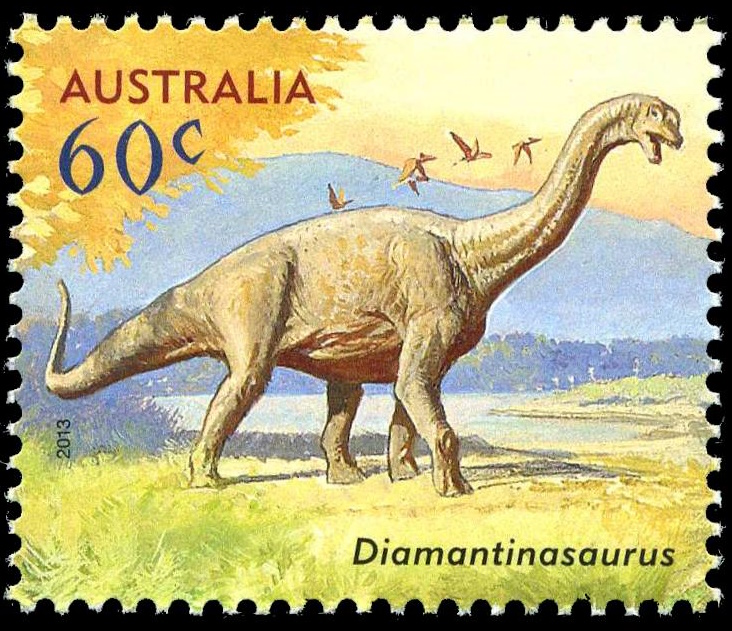
|
| Diamantinasaurus matildae on stamp of Australia 2013, MiNr.: 4021A, Scott: 3989. |
Meaning "Diamantina lizard", the genus name is derived from the location of the nearby Diamantina River and the Greek word sauros, "lizard". The species name is from the Australian song "Waltzing Matilda".
Diamantinasaurus were plant eaters with small teeth that were either pencil-like or spatulate (with a broad flat end).
Typically, they had long necks and small heads. Being able to eat enough plant matter with that tiny dental apparatus to keep their huge bodies alive is one argument that can be made for them being cold blooded, perhaps unlike many other dinosaurs. Cold-blooded animals require only about 10 per cent as much food as a warm-blooded creature of the same size. Early in their history, during the previous Jurassic period, sauropods were a diverse group. By the time that Diamantinasaurus lived, 95 million years ago, titanosaurs were one of the few sauropods left on Earth. They persisted right to the time of extinction of the non-avian dinosaurs, around 65.5 million years ago. Although large by the standards of any living land animal, being estimated at 16 metres in length, Diamantinasaurus was only a "moderate"-sized titanosaur. Another titanosaur known only from massive vertebrae and partial limb bones, Argentinosaurus, from South America, may have been the largest dinosaur that ever lived, with a minimum length estimated to have been 22 metres and a maximum of possibly more than 30 metres.
Fossils of Diamantinasaurus are held by the Australian Age of Dinosaurs Museum of Natural History in Winton, Queensland. Material was excavated and prepared in a joint Queensland Museum-Australian Age of Dinosaurs project.
Australovenator wintonensis
Australovenator (nicknamed "Banjo") was found not far from Winton, Queensland, at the same fossil site as Diamantinasaurus. Australovenator was 5–6 metres long and a swift predator.
This dinosaur was described in 2009 by Australian paleontologist Scott Hocknull and colleagues. The genus name Australovenator means "southern hunter". The species name refers to the town of Winton, where the fossils were found.
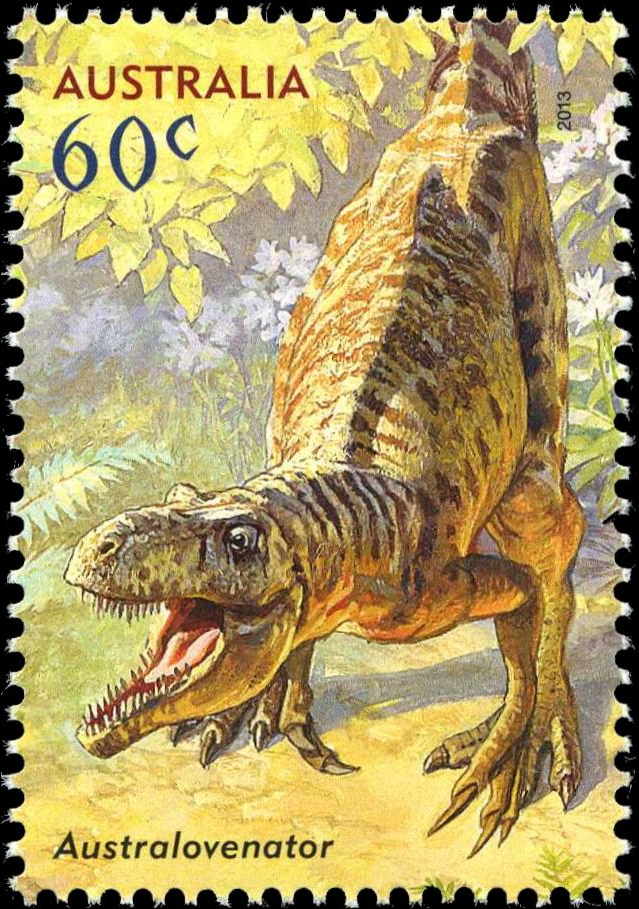
|

|
| Australovenator wintonensis on stamp of Australia 2013, MiNr.: 4022A, Scott: 3991. | Fukuiraptor on stamp of Japan 1999, MiNr.: 2635A, Scott: Z274. |
All the others are known from single, isolated bones only. Perhaps somewhat surprisingly, a dinosaur it closely resembles is Fukuiraptor, known from slightly older rocks in Japan.
However, allosauroids (named after the well-known Allosaurus), which are more distant and more advanced relatives in the same general grouping of carnivorous dinosaurs, are found on all the continents except Antarctica. A single anklebone about 20 million years older, which bears a remarkable resemblance to Australovenator, has been found on the coast of Victoria.
Despite the similarities, the age difference makes it unlikely that it was from Australovenator. Palaeontologists will need to find more of the skeleton from this Victorian dinosaur before it can be decided whether it is, in fact, Australovenator or some other dinosaur, probably as yet unnamed.
As is the case of all carnivorous dinosaurs Australovenator moved on two hind legs (bipedal) and had two smaller forelimbs. Although smaller, those forelimbs were deadly. On each of them were three scimitar-shaped claws — the internal one was the largest, about 14 centimetres long; the middle one about 11 centimetres in length; and the third, more gracile than the others, was six centimetres long. The claws alone made this dinosaur fearsome predator to be avoided by the herbivores that lived alongside it. Accompanying those claws was a complementary battery of sharp teeth, Australovenator was about two metres high at the hip and five metres long.
Products and associated philatelic items
| Mini-Sheet variations | ||
 |
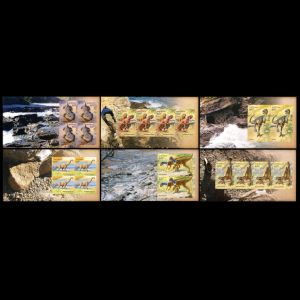 |
 |
| Embossed and imperforated Mini-Sheets are from the limited "Impressive Collection" folder | Perforated Mini-Sheets are from the "Prestige Booklet" | |
| Gutter pair | Self-adhesive booklets | |
 |
 |
 |
| Gutter pairs were printed in stripes of 10 (5x2) | The reverse side of the booklet is here | The reverse side of the booklet is here |
| FDC | ||
| FDC with gummed stamps | FDC with Mini-Sheet | FDC with self-adhesive stamps |
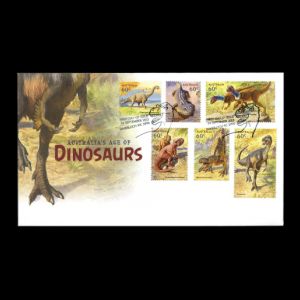 |
 |
 |
| Distinguished from 1993, FDC with the self-adhesive stamps wasn't offered by Australian Post. This cover was created on demand. | ||
| Signed FDC | ||
 |
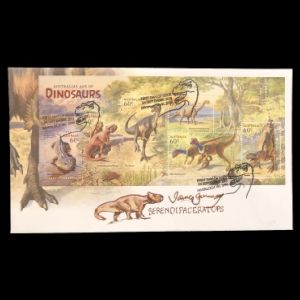 |
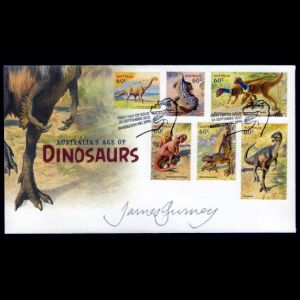 |
| FDC with Gutter-pairs | Personalized FDC | |
 |
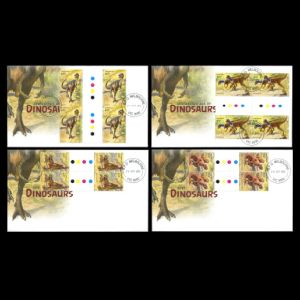 |
 |
| FDC with Gutter-pair stamps were produced on demand - gutter-pair stamps were cancelled by commemorative and regular postmarks of GPO Melbourne. | ||
| First-Day-of-Issue Postmark | Circulated FDC | |
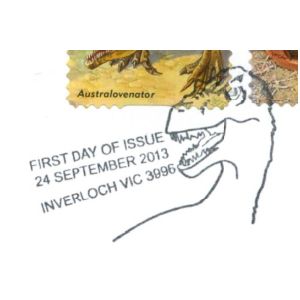 |
 |
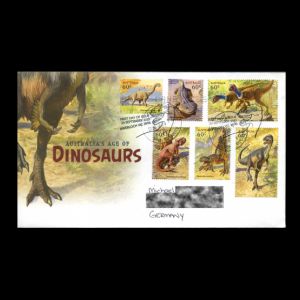 |
 |
 |
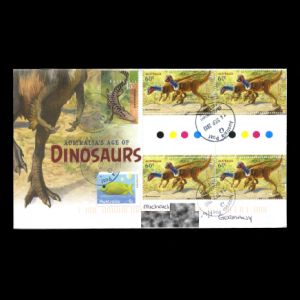 |
 |
 |
 |
| Example of Circulated Covers | ||
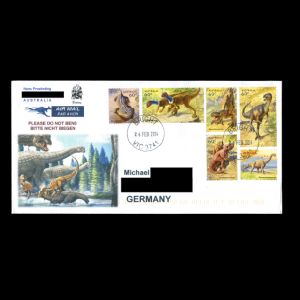 |
 |
|
| Set of Maxi Cards | Medallion Cover (single and triple) | |
 |
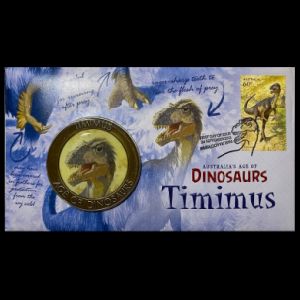 |
 |
| Prestige Booklet | Impression Collection folder | Presentation Pack |
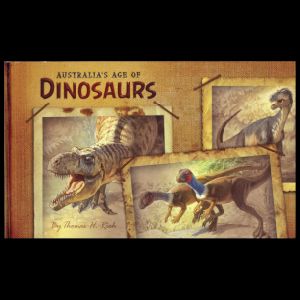 |
 |
 |
References
- Technical details and press releases:
- "Stamp Bulletin" of Australian Post, No. 324, September-October 2013
- "Australia's prehistoric past recognised with new stamp release" (this article of Australian Post doesn't exist anymore)
- Western Qld stamps authority on dinosaur finds at ABC News
- James Gurney:
- official Blog
- official website
- official YouTube channel
- Wikipedia
About James Gurney - "Australia's Age of Dinosaurs - Stamp Issue"
- "Evolution of Koolasuchus"
James Gurney about his work on the stamps - Australovenator wintonensis: Prestige-Booklet of Australian Post (the text was written by Dr. Thomas H. Rich), Wikipedia, Western Australian Museum,
- Diamantinasaurus matildae: Prestige-Booklet of Australian Post (the text was written by Dr. Thomas H. Rich), Wikipedia, Australian Museum.
- Koolasuchus cleelandi: Prestige-Booklet of Australian Post (the text was written by Dr. Thomas H. Rich), Wikipedia, Melbourne Museum: [1], [2]; Museums Victoria.
- Qantassaurus intrepidus: Prestige-Booklet of Australian Post (the text was written by Dr. Thomas H. Rich), Wikipedia, Australian Museum.
- Serendipaceratops arthurcclarkei: Prestige-Booklet of Australian Post (the text was written by Dr. Thomas H. Rich), Wikipedia
- Timimus: Prestige-Booklet of Australian Post (the text was written by Dr. Thomas H. Rich), Wikipedia
- Dinosaur Cove: Wikipedia
- Dr. Thomas H. Rich: Wikipedia, Museums Victoria,
- Potoroo: Wikipedia

|
Acknowledgements
Many thanks to Dr. Peter Voice from Department of Geological and Environmental Sciences, Western Michigan University, for his help to find an information for this article, the draft page review and his very valuable comments.| <prev | back to index | next> |